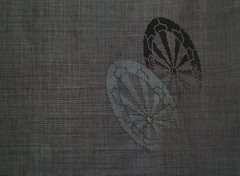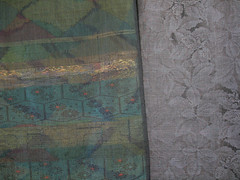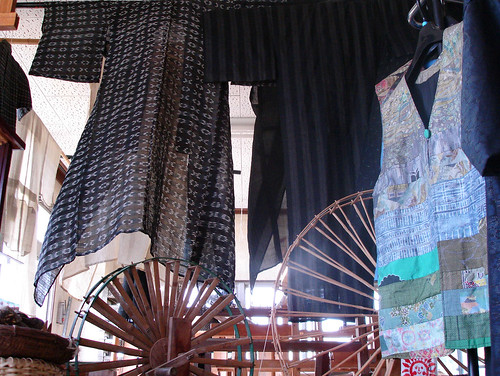tsumugi
A nondescript concrete building situated on the apex of the cape housed what looked like an art shop, so we walked in. The place displayed an interesting collection of traditional folk equipment of all sorts, as well as seashells, fossils, and the like. Beautiful silk garments made with the Amami ‘tsumugi’ cloth billowed in the gentle breeze. A peek in an adjoining room revealed a loom and more fabric and clothes. 

We had unwittingly walked into the studio and home of a local artist and admired the things within for a full 20 minutes when to everyone’s surprise he suddenly walked in from an adjoining room. It always happens by accident, but we seem to have the luck everywhere of running into the local staunch environmentalist. After we apologized for intruding, the artist (who designs and makes the garments completely by hand starting from raw silk) proceeded to show us around. We admired his use of patterns found on seashells or the colors of the sea at sunset. A 3-hour conversation ensued, turning quickly to the problem of the environment. If we had any delusions left about these islands being remote enough to be spared the usual destruction, they were quickly dispersed. I suppose we had already noticed that the waterfall and its stream by our campsite smelled a bit like sewage, but maybe we just tried to ignore it. Now we were told that the entire delicate aquifer of the island is thoroughly polluted, and most people drink bottled water. The waterfall above our camp actually had fully formed only after water had been diverted into the local village. Kuragou, the underground river in Sumiyoshi, is also polluted. Lack of sewage treatment and over-fertilization of the porous, infertile soil are the main causes. Some species of shells have disappeared over the years and fish are becoming scarce. More farmland is being developed, and forested areas along the island’s rim, which provide a natural wind barrier during typhoons, are being cleared. Many native trees are dying, a sight we had indeed witnessed the day before. The new port, of course, is not needed and its building had been opposed by many local citizens. Everywhere, it seems like it’s the same story.



0 Comments:
Post a Comment
<< Home